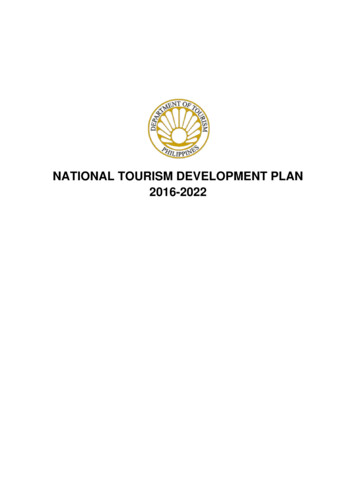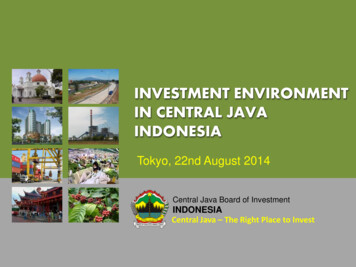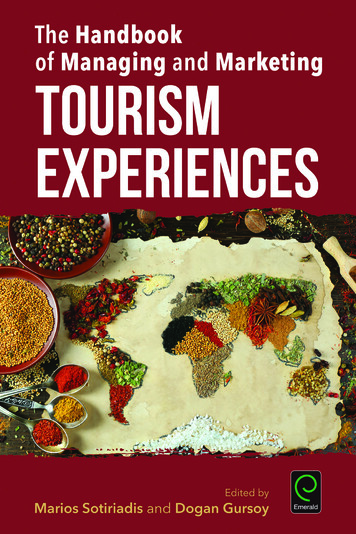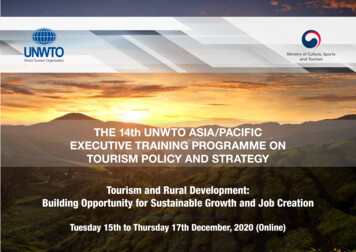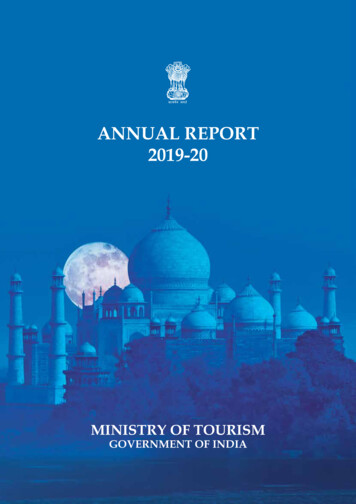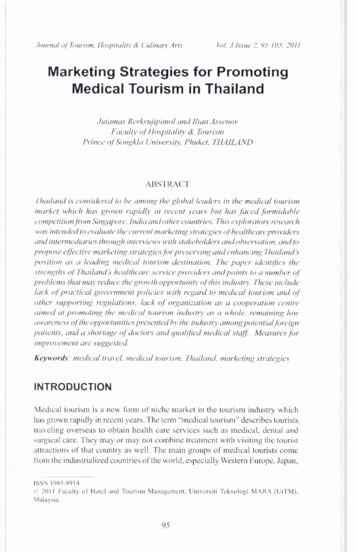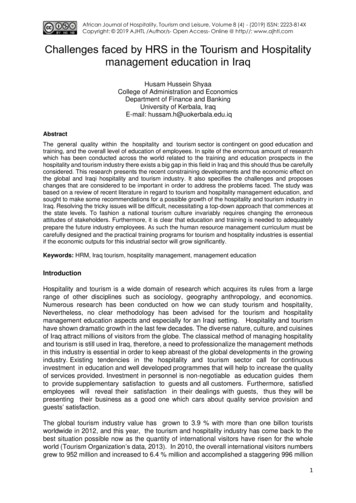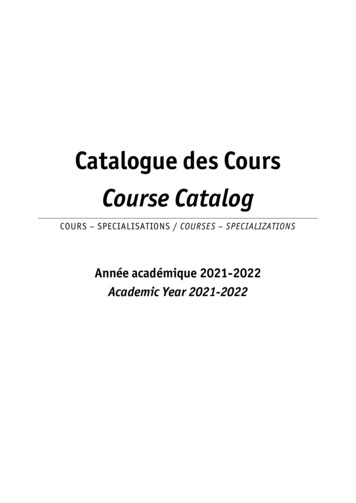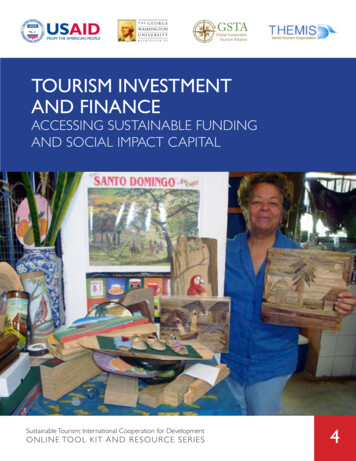
Transcription
GSTAGlobal SustainableTourism AllianceTOURISM INVESTMENTAND FINANCEACCESSING SUSTAINABLE FUNDINGAND SOCIAL IMPACT CAPITALSustainable Tourism: International Cooperation for DevelopmentO N L I N E TO O L K I T A N D R E S O U R C E S E R I E S4
Sustainable Tourism: International Cooperation for DevelopmentON L IN E TO O L K IT AND RE S O U RCE S E RIE Shttp://lms.rmportal.net/course/category.php?id 51ST101. Global TourismAchieving Sustainable GoalsST102. Project Development for Sustainable TourismA Step by Step ApproachST103. Tourism Destination ManagementAchieving Sustainable and Competitive ResultsST104. Tourism Investment and FinanceAccessing Sustainable Funding and Social Impact CapitalST105. Sustainable Tourism Enterprise DevelopmentA Business Planning ApproachST106. Tourism Workforce DevelopmentA Guide to Assessing and Designing ProgramsST107. Tourism and ConservationSustainable Models and StrategiesST108. Scientific, Academic, Volunteer, and Educational TravelConnecting Responsible Travelers with Sustainable DestinationsST109. Powering TourismElectrification and Efficiency Options for Rural Tourism Facilities
GSTAGlobal SustainableTourism AllianceTOURISM INVESTMENTAND FINANCEACCESSING SUSTAINABLE FUNDINGAND SOCIAL IMPACT CAPITALSustainable Tourism: International Cooperation for DevelopmentON L I NE TO O L K I T AN D R ES O U R CE S ER I ESPrimary AuthorsJim PhillipsJamie FaulknerSolimar InternationalContributorsRoberta Hilbruner, USAIDDonald E. Hawkins, George Washington UniversityThis publication is made possible by the support of the American People through the United StatesAgency for International Development to the Global Sustainable Tourism Alliance cooperative agreement#EPP-A-00-06-00002-00. The contents of this publication are the sole responsibility of the author(s) anddo not necessarily reflect the views of USAID or the United States Government.
Table of ContentsTable of Contents . 1Acronyms . 2Preface. 4Unit 1: Identify Trends and Opportunities. 6Unit 2: Evaluate Investment Environment . 21Unit 3: Project Identification. 33Unit 4: Financial Feasibility . 49Unit 5: Project Definition, Design, and Promotion . 55Unit 6: Identify and Access Funding . 63Unit 7: Monitor and Evaluate Sustainable Tourism Investment and Finance Projects . 80Glossary . 92References . 95Annex A: RFP Example from TourismROI.com . 100Annex B: Tourism Sector Diagnostic Tool Investment Drivers . 103In accordance with Title 17 U.S.C. section 107, any copyrighted material herein is distributedwithout profit or payment for non-profit research and educational purposes only. If you wish touse copyrighted materials from this publication for purposes of your own that go beyond “fairuse,” you must obtain permission from the copyright owner.International Institute for Tourism StudiesThe George Washington University 2201 G Street, NWWashington, DC 20052
AcronymsAED — Academy for Educational DevelopmentADB — African Development BankAFD — French Development AgencyAI — African InvestorBRIC — Brazil, Russia, India, and ChinaCI — Conservation InternationalCEED — Center for Entrepreneurship and Executive DevelopmentCREST — Center for Responsible for TravelCSR—- Corporate Social ResponsiblyDANTEI — Development Assistance Network for Tourism Enhancement and InvestmentDAI — Development Alternatives, Inc.DMO — Destination Management OrganizationESTA — Ecuador Sustainable Tourism AllianceFDI — Foreign Direct InvestmentGDP — Gross Domestic ProductGEF — Global Environment FundGDA — Global Development AllianceGIIN — Global Impact Investing NetworkGSTA — Global Sustainable Tourism AllianceGSTC — Global Sustainable Tourism CriteriaGW — The George Washington UniversityIC — Investor’s CircleIDB — Inter-American Development BankIFC — International Finance CorporationIFI — International Financial InstitutionsIPA — Investment Promotion AgencyIPI — Investment Promotion IntermediariesTOURISM INVESTMENT & FINANCE2
IRIS — Impact Reporting and Investment StandardsIRR — Internal Rate of ReturnLDC — Least Developed CountriesMDG — Millennium Development GoalsMIGA — Multilateral Investment Guarantee AgencyNGO — Nongovernmental OrganizationNPV — Net Present ValueOPIC — Overseas Private International CorporationODA — Official Development AssistanceP&L — Profit and LossSEAF — Small Enterprise Assistance FundsSGB — Small and Growing BusinessesSIFT — Sustainable Investment and Finance in Tourism NetworkSMEs — Small and Medium Sized EnterpriseST — Sustainable TourismSWOT — Strengths, Weaknesses, Opportunities, and ThreatsROI — Return on InvestmentTI — Transparency InternationalTNC — The Nature ConservancyT&T — Travel and TourismUNCED — United Nations Conference on Environment and DevelopmentUNCTAD — United Nations Conference on Trade and DevelopmentUNDP — United Nations Development ProgramUNEP — United Nations Environment ProgramUNWTO— United Nations World Tourism OrganizationUSAID — United States Agency for International DevelopmentWBG — World Bank GroupWEF — World Economic ForumWTO — World Tourism OrganizationWTTC — World Travel & Tourism CouncilTOURISM INVESTMENT & FINANCE3
PrefaceAs one of the world’s largest industries, tourism has grown rapidly and continuously for morethan half a century and has become a significant source of global employment and economicoutput. The World Travel & Tourism Council (WTTC) reported that in 2010 tourism directlycontributed to 2.8% of global GDP, accounted for 259 million direct jobs, and 4% of globalinvestment.Including indirect impacts, WTTC estimates that in 2011 the industry will contribute nearly US 6trillion to global output, or 9% of world GDP. Travel and tourism investment is expected to reachUS 652.4 billion in 2011 and is forecast to increase to US 1.5 trillion by 2021 (World Travel &Tourism Council and Oxford Economics, 2011).Tourism is also the top export earner in 60 countries and the primary source of foreignexchange earnings for one third of developing countries and one half of least developedcountries (UNCTAD, 2010).Developing countries particularly benefit from the tourism industry’s positive economic,environmental, and social impacts, through the creation of jobs, preservation and celebration ofindigenous culture, reduction of poverty, and promotion of environmental conservation(environmentally-friendly alternative livelihoods). In Tanzania, for example, “gross tourismreceipts accounted for less than 10% of total export earnings in the 1980s. By 2000, tourismwas the top export earner, above coffee and cotton, and now accounts for over 35% of totalgoods and services exports” (UNCTAD, 2010).International development agencies and developing countries have recognized the numerouspositive impacts of tourism and actively pursue tourism development to promote economicgrowth and development assistance objectives.Tourism can also have negative impacts. Particular attention must be paid to environmental andsocial concerns, as well as pressure placed on non-renewable resources and infrastructure.Assessing and managing these impacts is a core function of the investment promotion processoutlined here.This Guide provides development practitioners with the information and tools necessary tosuccessfully facilitate the financing of small-scale, sustainable tourism projects, and to transferthese skills to their clients and counterparts.TOURISM INVESTMENT & FINANCE4
More specifically, it is designed to assist organizations and individuals working with micro, small,and medium-sized enterprises to conduct pre-feasibility studies, understand the market andfinancial analysis process, prepare investment briefs, identify potential sources of financing,understand how deals and joint ventures are structured, and work with governments to removebarriers to investment and provide broader access to credit. It also includes lessons learnedfrom past experiences and successful efforts to facilitate sustainable investment and financing.There are elements of this process that will likely require the assistance of specialists and thirdparty professionals, particularly for larger projects or where commercial sources of debt andequity financing are required. In working with outside investors, project sponsors will also, inmost cases, require the assistance of legal advisors, to help navigate the legal requirements ofthe host country.We would like to thank Chris Seek, Keith Dokho, and Melissa Moye, without whose review andinsight this toolkit would not have been possible. The Global Sustainable Tourism AllianceManagement Partners — FHI360, The George Washington University, Solimar International,and The Nature Conservancy — also provided helpful guidance.We would also like to express our deep appreciation and gratitude to Donald E. Hawkins,Annessa Kaufman, and Kristin Lamoureux of The George Washington University, who sharedtheir knowledge and experience in the production of this publication, and to the UN WorldTourism Organization and its Themis Foundation for permission to utilize information from theirpublications and to pilot test this publication.Last, we would last like to thank Roberta Hilbruner, who helped make the development andpublication of this Guide possible, and whose unparalleled championship of sustainable tourismhas positively affected innumerable destinations and people throughout the world.Sincerely,Jim Phillips and Jamie FaulknerTOURISM INVESTMENT & FINANCE5
Unit 1: Identify Trends and OpportunitiesAt the end of this unit, participants will be able to: Understand and find additional information on global tourism trendsBecome familiar with sustainable tourism investment trends and opportunitiesBecome familiar with basic investment concepts and learn about institutions activelyproviding access to capital for sustainable investment projectsUnderstand the benefits of sustainable tourism investment for local communities andeconomiesGlobal, regional, national, and local tourism and investment trends all influence the viability of aproposed project. Understanding these trends is the first step in identifying investmentopportunities, quantifying market potential, determining capital requirements, and assessingfinancial feasibility.GLOBAL TOURISM TRENDSDemographic and psychographic changes, such as the aging of populations in industrializedcountries (the primary market for most international travel destinations), increasing interest inmore active and educational pursuits (“sight doing” vs. “sight seeing”), and greater concern forthe environment are just a few trends shaping destination development across the globe.The rapid emergence of new outbound travel markets, like China, India, Brazil, and Russia(BRIC) is another major trend, both in terms of travel demand and sources of investment fortourism projects.TOURISM INVESTMENT & FINANCE6
RESOURCE 1.1OUTBOUND MARKET DATA: EUROPEAN TRAVEL COMMISSION (ETC)The ETC is a world leader in the collection, analysis, and reporting of tourism data. Its mostrecent quarterly report provides insights into trends in major outbound markets, including thegrowth of the Chinese market, increasing at a rate of over 10% per year over the past decade,and the lack of growth in more traditional markets (2000–2010), including Germany (0.1%), theUK (0.4%), and the US inal.pdfThe removal of barriers to travel, including the easing of entry requirements and the adoption ofopen skies policies (for new airline routes, code sharing agreements, etc.) are also increasingtravel supply and demand.Visitor expectations are also changing, as are motivations for travel. While cultural heritagetourism remains one of the largest and fastest growing global travel markets, new market nichesare emerging on a daily basis. The primary trend is increasing market fragmentation, as theinternet, social media, and other tools increasingly allow travelers and the travel trade to tailortrips to more specific and more specialized interests (e.g., landscape photography and Arabiccooking). This trend is creating a wide variety of opportunities for emerging destinations tocreate travel experiences that can, if effectively promoted, quickly find markets.Another important trend is the increasing interest in nature-oriented travel, as the environmentalthreats of population growth, the rapid expansion of extractive industries (oil, gas, minerals), andglobal climate change become better known. While many of the world’s most unique andoutstanding natural attractions are located in developing countries, these same resources arealso some of the most threatened, by resource extraction, the changing climate and theencroachment of human populations on fragile, biodiversity-rich ecosystems.Sustainable tourism development has significant potential to create alternative, sustainablelivelihoods and alternative sources of income for developing economies, and help place aneconomic value on threatened natural resources.TOURISM INVESTMENT & FINANCE7
BOX 1.1ENVIRONMENTAL IMPACT EXAMPLE: MILLION DOLLAR REEF SHARKSA recent study by Mark Meekan of the Australian Institute of Marine Science estimates that thevalue of a reef shark killed to make shark fin soup to the tiny island nation of Palau is aboutUS 108. According to the study, the estimated value of that same shark to Palau’s sharkdiving industry, which contributes more than 18 million annually, was more than 179,000 peryear, or 1.9 million over the shark’s lifetime.The study also noted that shark diving contributes more than 800 million per year to theBahamian economy, more than 100 million to Thailand’s economy, and accounted for morethan 25% of travel-related spending for visitors to the Great Barrier Reef, one of the world’smost popular natural nce/earth/02shark.htmlThe broader trend emerging from the fragmentation and specialization of international travelmarkets, the growing desire for more active travel pursuits, and the increasing interest in thenatural environment, is evident through the acceleration in the rate of growth of visitor arrivalsand spending in the developing world.While the long-term trend in total international arrivals has remained fairly steady, at 4–5% peryear, overnight arrivals in many developing regions and countries have far exceeded thataverage, often at the expense of more traditional vacation destinations like Western Europe andNorth America. Over the past decade that trend has been most pronounced in Africa and theMiddle East, with Latin America, Eastern Europe, and parts of southern Asia not far behind(Figure 1.1).TOURISM INVESTMENT & FINANCE8
Figure 1.1. International Tourism Arrivals, 1950–2020: Current Situation and Forecasts(UNWTO, 2008)TOURISM ECONOMIC IMPACTThe direct economic impacts of tourism development are primarily measured in terms of visitorspending on accommodations, entertainment, attractions, food and beverage, andtransportation, for both domestic and international travel. There are also, however, significantindirect and induced impacts that should be measured, resulting from the recirculation of thatspending within local economies, and the jobs created and income generated by companiesthat supply the industry.The World Travel and Tourism Council estimates that the total impact of travel and tourism onglobal economic output will reach 9.2 trillion by 2021 (Figure 1.2).TOURISM INVESTMENT & FINANCE9
Figure 1.2. World Travel & Tourism Outlook (WTTC & Oxford Economics, 2011b)Despite the recent financial crisis, tourism has contributed approximately 3% to global outputover the past decade, including an estimated 1.8 trillion in 2010, or a nearly 80%increase over2000 levels (Figure 1.3).200018001600US Billion14001200100080060040020002000 2001 2002 2003 2004 2005 2006 2007 2008 2009 2010 2011Figure 1.3. Travel & Tourism Direct Contribution to GDP (World Travel and Tourism Council,2011b)TOURISM INVESTMENT & FINANCE10
RESOURCE 1.2ECONOMIC IMPACT OF TOURISM — WORLD TRAVEL AND TOURISMCOUNCILTo better understand tourism’s impact on a destination’s economy, and for regularly updatedtourism data, trends and indicators refer to these World Travel and Tourism Council resources:Tourism Research, www.wttc.org/eng/Tourism ResearchMonthly Update on Travel and Tourism Indicators,www.wttc.org/eng/Tourism Research/Economic Research/Monthly Update of Tourism IndicatorsTourism Economic Impact,www.gwu.edu/ iits/Sustainable Tourism Online Learning/Faulkner/WTTC economic impact.pdfOne of the fastest growing regions (in terms of visitor arrivals and spending) over the pastdecade is sub-Saharan Africa, where sustainable tourism has the potential to reduce povertyand protect threatened ecosystems and cultures. Sub-Saharan Africa is home to the world’s tenpoorest countries, based on estimated per capita GDP (World Travel & Tourism Council andOxford Economics, 2011a), and home to some of the planet’s fastest growing tourismdestinations.Table 1.1. World’s Fastest Growing Economies (The Economist, ISM INVESTMENT & 6.9%6.8%11
The World Bank predicts that Africa is on the brink of an economic takeoff, much like China 30years ago and India 20 years ago (World Bank Group, 2011a). More than half of the world’sfastest growing economies are in Sub-Saharan Africa (Table 1.1) and it is predicted that Africa’seconomy will grow at an average rate of 7% over the next 20 years, catching up to andeventually surpassing China’s growth rate (The Economist, 2011).SUSTAINABLE TOURISM TRENDSThe rapid growth of tourism in many developing countries also introduces new threats to theenvironment. Water and energy consumption, utilization of natural resources, and increasedwastes are just some potential negative environmental impacts. Through sustainable forms oftourism development many of these impacts can be mitigated.Additional toolkits in this course series provide additional details, tools, and information relatedto supplementary tourism trends. The complete listing of the courses are listed on the insidecover of this publication with information on how to access them.Sustainable tourism development is also smart business, as a growing numbers of travelersincreasingly seek environmentally friendly vacation destinations. According to the UNEP GreenEconomy Report (2011), global spending on ecotourism is increasing by 20% per year.International donors, IFIs, and the private sector support this trend. The Sustainable Investmentand Financing of Tourism (SIFT) project, for example, defines and promotes sustainabilitycriteria for tourism-related investment as well as provides relevant data, tools, and financingoptions to integrate sustainability into the tourism development and investment process (Centerfor Responsible Travel, 2009).TOURISM INVESTMENT TRENDSAccording to the WTTC, overall travel and tourism related investment totaled nearly 612 billionin 2010 and is expected to reach 652 billion in 2011 (Figure 1.4), or 4.5% of total globalinvestment.TOURISM INVESTMENT & FINANCE12
800700US 200620072008200920102011Figure 1.4. Travel and Tourism Capital Investment (World Travel and Tourism Council, 2011b)In 2010, travel and tourism investment in Africa comprised 9.2% of total investment, or morethan US 1.2 billion, and is projected to reach 2.7 billion by 2020 (Shanna, 2010).One of the most important trends shaping tourism-related investment, and investment indeveloping countries in general, is investment in projects using a Triple Bottom Line approach,which seeks returns on investment that are financial, social, and environmental (Figure 1.5).TOURISM INVESTMENT & FINANCE13
Figure 1.5. Triple Bottom Line (Elkington, 1994)A related trend is social investing, where the primary focus is on using investment to affectsocial change. Also referred to as socially responsible investing (SRI), the aim is to evaluatesocial impacts of investments, both positive and negative. According to The Social InvestmentForum (www.ussif.org), SRI now accounts for more than 10% of total U.S. investment (US SIF:The Forum for Sustainable and Responsible Investment, undated).A more recent and closely related trend is impact investing, which in general is more project- orventure capital-focused, as opposed to social investing, which typically focuses more onportfolio investment (minority stakes in a range of investments, through securities and othermore traditional investment vehicles).Impact investing blends philanthropy and private equity to more sustainably achievephilanthropic objectives through the development of self-financing initiatives and enterprises thatgenerate triple bottom line returns.Recently, networks of angel investors, professional venture capitalists, and foundations such asthe Investor’s Circle (www.investorscircle.net) have been created to promote impact investmentby sharing knowledge, experiences, and resources, and provide funding for projects.Some of the leading organizations in the impact investing movement include: Acumen Fund, www.acumenfund.org Avantage Ventures, www.avantageventures.comTOURISM INVESTMENT & FINANCE14
Verde Ventures, tnerlanding.aspx E Co, http://eandco.net Grassroots Business Fund, www.gbfund.org Global Partnerships, www.globalpartnerships.org Bamboo Finance, www.bamboofinance.com Root Capital, www.rootcapital.org TBL Capital (TBL), www.tblcapital.com Truestone Impact Investment Management Limited, London - Fund of t/documents/IMTruestone Global Impact Fund-Fund summary.pdf TreeTops Capital, www.treetopscapital.com Jonathan Rose Companies, LLC, www.rose-network.com GIIRS Pioneer Funds, www.giirs.org/for-funds/pioneer LGT Venture Philanthropy, www.lgt.com/en/private kunden/philanthropie/index.html Origen Private Equity Limited, http://origenprivateequity.com BlueVine Ventures LLC, http://web62331.aiso.net/about.html WillowTree Impact Investors, itment.htmlThe US Government is also a major supporter of impact investing. The Overseas PrivateInvestment Corporation (OPIC) recently issued its first ever call for proposals to catalyzesupport for impact investments — “a fast-growing sector that is drawing investors with thepromise of targeting and delivering positive social and environmental impacts to emergingmarkets while at the same time generating profits” (Overseas Private Investment Corporation,2011).Private capital has an important role to play in helping solve development challenges,especially when development budgets are under pressure. With this call, OPIC seeks tocatalyze the field’s growth, by encouraging innovation, mitigating risks and committingcapital to attract more private investment. — OPIC President and CEO ElizabethLittlefield (Overseas Private Investment Corporation, 2011)USAID also leads in promoting impact investing. It collaborated with the Rockefeller Foundation,Global Impact Investing Network (GIIN), and JP Morgan Chase to develop Impact Reporting &Investment Standards (http://iris.thegiin.org) (IRIS), which rates social and environmentalreturns on financial investments.TOURISM INVESTMENT & FINANCE15
Another strategy is community investing which provides underserved communities with accessto capital and credit. In tourism terms, investments typically focus on micro- and smallenterprises and infrastructure-related projects (sanitation, health, transportation, electrification)that serve both local residents and visitors. The Community Investment Center conductsresearch and provides information and contacts, including a searchable database of communityinvestment specialists around the world (www.socialfunds.com/ci/index.cgi).Investors behind sustainable tourism projects can allocate funds to community projectcomponents such as accommodations (guest houses, home stays, ecolodges, etc.). Other smallbusiness creation initiatives empower women and young people and include sustainable localfood production and handicrafts to sell to tourists. Community-based tourism focused on localwomen’s groups and co-operatives allow entry for women into the workforce in manydeveloping countries.An example of a successful community investment initiative is UNEP’s Small Grants Programon behalf of the Global Environment Facility (GEF) in Costa Rica. Supporting the developmentof rural community-based tourism as a sustainable livelihood, the Costa Rican Association ofCommunity-based Rural Tourism .php) strengthens community-based ruraltourism throughout the country. GEF assisted ACTUAR by funding Los Campesinos Reserve inthe Savegre River Basin, east of Quepos and Manuel Antonio National Park. The local lodgerequired upgrades to increase capacity and improve operation sustainability. The Small GrantsProgram provided 2,500 to construct a small tourist receiving area and restrooms. Oncebusiness increases, the loan can be repaid.Microfinance is another significant financing mechanism focused on poverty alleviation andsustainable development. It provides financial services (loans, savings accounts, transfers) tothe poor. Specifically it provides credit to budding entrepreneurs with little or no collateral inamounts considered far too small (typically between 100 and 1,000) to interest commerciallenders (Figure 1.6). Microenterprises include small retail shops, artisanal manufacturing, andstreet vendors. One example of a micro-lending program is Kiva.org, a non-profit organization(www.kiva.org) that supports microfinance by connecting individuals capable of providing nocost funding to microfinance institutions around the world that then make loans and managerepayments.TOURISM INVESTMENT & FINANCE16
Figure 1.6. Microfinance Can Reach the Lower Income Levels (Prahalad, 2009)RESOURCE 1.3GENDER & TOURISM — WOMEN’S EMPLOYMENT AND PARTICIPATIONIN TOURISM — SUMMARY OF UNED-UK’S PROJECT REPORTThe report explores issues related to women’s employment in the tourism industry andwomen’s local participation in tourism planning and management. Discussions include genderstereotyping, micro-credit, etc., as well as brief spotlights on individual countries.www.gwu.edu/ iits/Sustainable Tourism Online Learning/Faulkner/Women,Gender&Tourism.docDIASPORA INVESTMENTDiasporas are transnational communities maintaining connections with their countries of origin.Remittances from migrants and their descendants can be the largest source of financial inflowsTOURISM INVESTMENT & FINANCE17
to many developing countries (Figure 1.7). Diaspora investors can contribute to sustainabledevelopment by transferring resources, knowledge, and capital back home.450400US billions350300250200Inward remittance flowsAll developing countries - InwardOutward remittance flowsAll developing countries - 10eFigure 1.7. Remittance Flows (Ratha, Mohapatra & Silwal, 2011)RESOURCE 1.4DIASPORA INVESTMENT — USAID AND MIGRATION POLICY INSTITUTEDIASPORA INVESTMENT IN DEVELOPING AND EMERGING COUNTRYCAPITAL MARKETSThis report goes beyond the traditional impact of remittances and diaspora investment onfinancial market development and discusses additional vehicles to mobilize diaspora wealth viacapital markets:1) Deposit accounts denominated in local and foreign currencies2) Securitization of remittance flows allowing banks to leverage remittance receipts3) Transnational loans allowing diaspora to purchase real estate and housing in countriesof origin4) Diaspora bonds allowing governments to borrow long-term funds5) Diaspora mutual funds mobilizing pools of individual investors for collective investmentsin c
ST103. Tourism Destination Management Achieving Sustainable and Competitive Results ST104. Tourism Investment and Finance Accessing Sustainable Funding and Social Impact Capital ST105. Sustainable Tourism Enterprise Development A Business Planning Approach ST106. Tourism Workforce Development A Guide to Assessing and Designing Programs ST107.
